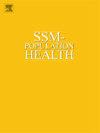Education, urbanicity of residence, and cardiometabolic biomarkers among middle-aged and older populations in the US, Mexico, China, and India
IF 3.6
2区 医学
Q1 PUBLIC, ENVIRONMENTAL & OCCUPATIONAL HEALTH
引用次数: 0
Abstract
Background
The relationship between education and cardiometabolic biomarkers is contextually dependent on both inter-country and intra-country factors. This study aimed to examine educational differences in cardiometabolic biomarkers among middle-aged and older adults in the US, Mexico, China, and India, and whether this relationship is modified by urbanicity of residence.
Methods
Data were from contemporary cross-sectional waves of the US Health and Retirement Study (HRS; 2016/17, n = 19,608), the Mexican Health and Aging Study (MHAS; 2015, n = 12,356), the China Health and Retirement Longitudinal Study (CHARLS; 2015/16, n = 13,268), and the Longitudinal Aging Study in India (LASI; 2017/19, n = 47,838). To account for substantial variations in educational distribution across the four countries, we measured education attainment in two ways: by categorizing education levels into binary classifications (‘lower education: lower secondary education or below' vs. 'higher education: upper secondary education or above') to assess absolute education attainment, and by using within-country percentile ranks to capture relative education attainment. We assessed educational differences in four cardiometabolic biomarkers: body mass index (BMI), systolic blood pressure (SBP), glycated haemoglobin (HbA1c), and total cholesterol. We tested whether urbanicity of residence modified the relationship between education and these cardiometabolic biomarkers.
Results
The proportion of individuals with higher education was 82.6% in the US, 15.6% in Mexico, 10.6% in China, and 16.8% in India. In the US, higher education was associated with lower SBP (−2.74 mmHg, 95% CI: −3.62, −1.86) and HbA1c (−0.14%, 95% CI: −0.20, −0.08), but higher total cholesterol (3.33 mg/dL, 95% CI: 1.41, 5.25). In Mexico, higher education was associated with lower BMI only (−0.51 kg/m2, 95% CI: −0.76, −0.26). In China, higher education was not associated with any biomarker. In India, higher education was associated with higher BMI (1.61 kg/m2, 95% CI: 1.49, 1.73), SBP (1.67 mmHg, 95% CI: 1.16, 2.18), and HbA1c (0.35%, 95% CI: 0.19, 0.51). The association between education and cardiometabolic biomarkers was modified by urbanicity in China and India but not in the US or Mexico. In both China and India, relationships between education and cardiometabolic biomarkers were stronger among rural residents compared to those among urban residents. Results based on relative education attainment showed similar patterns in terms of the direction of the effect estimates, despite some discrepancies in statistical significance.
Interpretation
There is a complex relationship between education and cardiometabolic biomarkers across countries and by urbanicity of residence. This complexity underscores the importance of accounting for contextual factors when devising strategies to enhance cardiometabolic health in various settings.
美国、墨西哥、中国和印度中老年人群的教育程度、居住地城市化程度和心脏代谢生物标志物
背景教育与心脏代谢生物标志物之间的关系取决于国家间和国家内的具体情况。本研究旨在探讨美国、墨西哥、中国和印度中老年人心脏代谢生物标志物的教育差异,以及这种关系是否会因居住地的城市化而改变。方法数据来自美国健康与退休研究(HRS;2016/17,n = 19,608)、墨西哥健康与老龄化研究(MHAS;2015,n = 12,356)、中国健康与退休纵向研究(CHARLS;2015/16,n = 13,268)和印度老龄化纵向研究(LASI;2017/19,n = 47,838)的当代横截面波。为了考虑这四个国家教育分布的巨大差异,我们用两种方法衡量教育程度:将教育水平分为二元分类("低等教育:初中或以下 "与 "高等教育:高中或以上"),以评估绝对教育程度;使用国家内百分位数排名来反映相对教育程度。我们评估了四个心脏代谢生物标志物的教育差异:体重指数(BMI)、收缩压(SBP)、糖化血红蛋白(HbA1c)和总胆固醇。我们测试了居住地的城市化程度是否会改变教育程度与这些心脏代谢生物标志物之间的关系。结果在美国,受过高等教育的人占 82.6%,在墨西哥占 15.6%,在中国占 10.6%,在印度占 16.8%。在美国,高等教育与较低的 SBP(-2.74 mmHg,95% CI:-3.62,-1.86)和 HbA1c(-0.14%,95% CI:-0.20,-0.08)有关,但与较高的总胆固醇(3.33 mg/dL,95% CI:1.41,5.25)有关。在墨西哥,高学历仅与较低的体重指数相关(-0.51 kg/m2,95% CI:-0.76,-0.26)。在中国,高等教育与任何生物标志物都无关。在印度,高学历与较高的体重指数(1.61 kg/m2,95% CI:1.49,1.73)、SBP(1.67 mmHg,95% CI:1.16,2.18)和 HbA1c(0.35%,95% CI:0.19,0.51)相关。在中国和印度,教育程度与心血管代谢生物标志物之间的关系因城市化程度而改变,但在美国和墨西哥则没有。在中国和印度,与城市居民相比,农村居民受教育程度与心脏代谢生物标志物之间的关系更为密切。根据相对教育程度得出的结果显示,尽管在统计显著性方面存在一些差异,但在效应估计值的方向方面呈现出相似的模式。这种复杂性强调了在不同环境下制定增强心脏代谢健康的策略时考虑环境因素的重要性。
本文章由计算机程序翻译,如有差异,请以英文原文为准。
求助全文
约1分钟内获得全文
求助全文
来源期刊

Ssm-Population Health
PUBLIC, ENVIRONMENTAL & OCCUPATIONAL HEALTH-
CiteScore
6.50
自引率
2.10%
发文量
298
审稿时长
101 days
期刊介绍:
SSM - Population Health. The new online only, open access, peer reviewed journal in all areas relating Social Science research to population health. SSM - Population Health shares the same Editors-in Chief and general approach to manuscripts as its sister journal, Social Science & Medicine. The journal takes a broad approach to the field especially welcoming interdisciplinary papers from across the Social Sciences and allied areas. SSM - Population Health offers an alternative outlet for work which might not be considered, or is classed as ''out of scope'' elsewhere, and prioritizes fast peer review and publication to the benefit of authors and readers. The journal welcomes all types of paper from traditional primary research articles, replication studies, short communications, methodological studies, instrument validation, opinion pieces, literature reviews, etc. SSM - Population Health also offers the opportunity to publish special issues or sections to reflect current interest and research in topical or developing areas. The journal fully supports authors wanting to present their research in an innovative fashion though the use of multimedia formats.
 求助内容:
求助内容: 应助结果提醒方式:
应助结果提醒方式:


